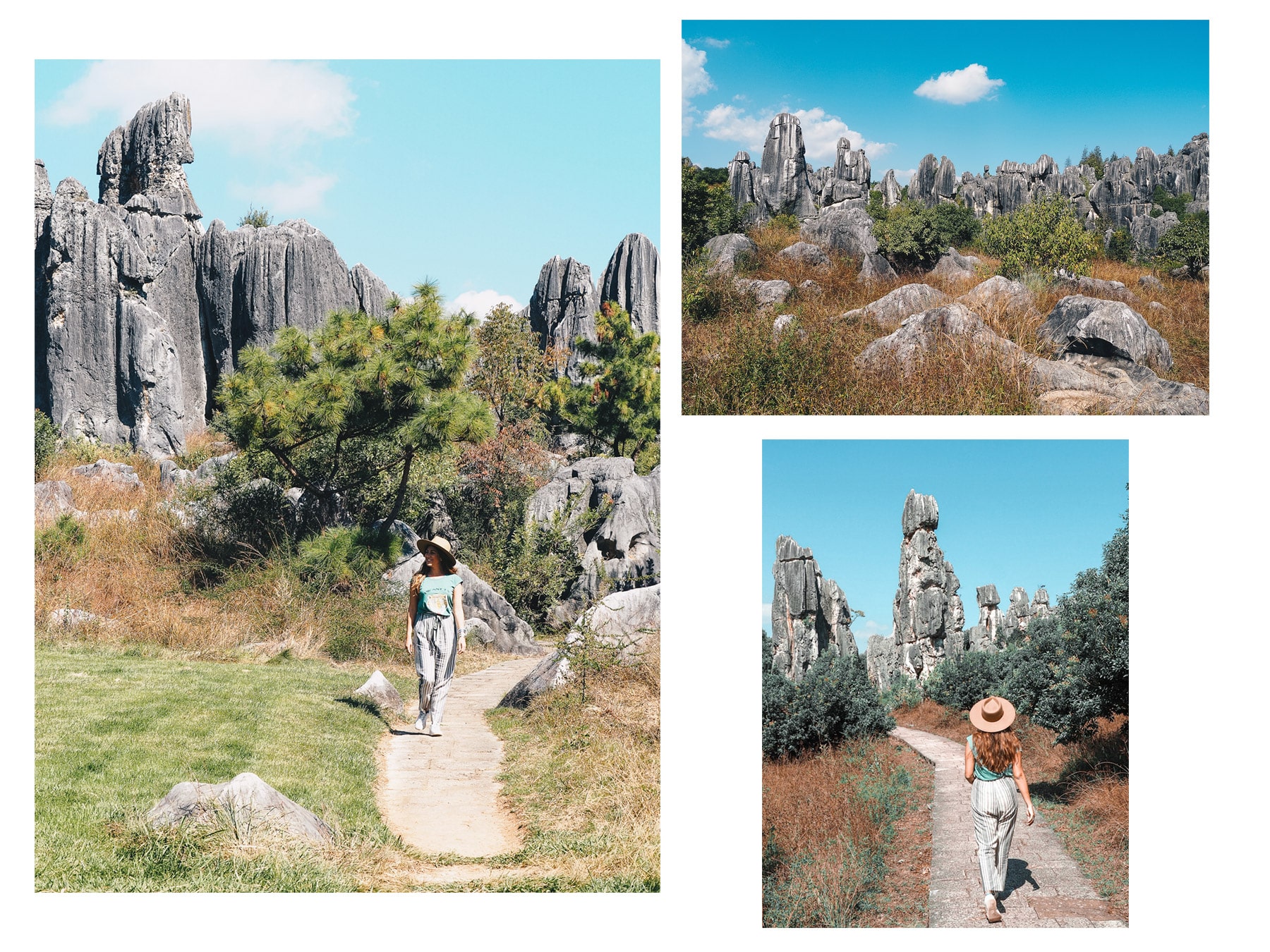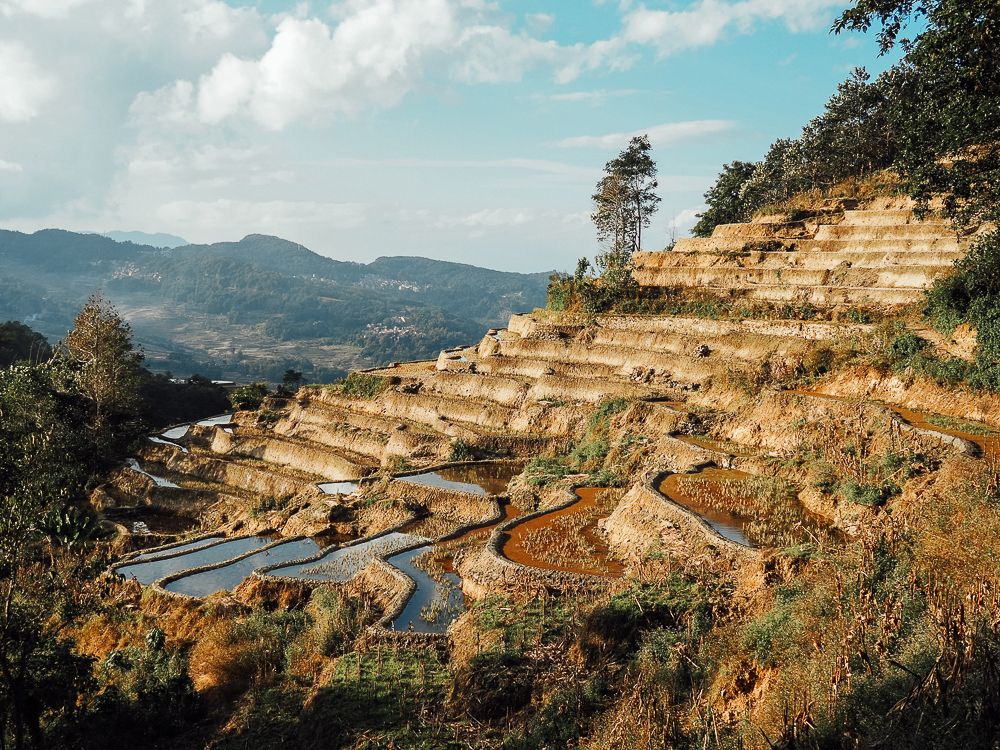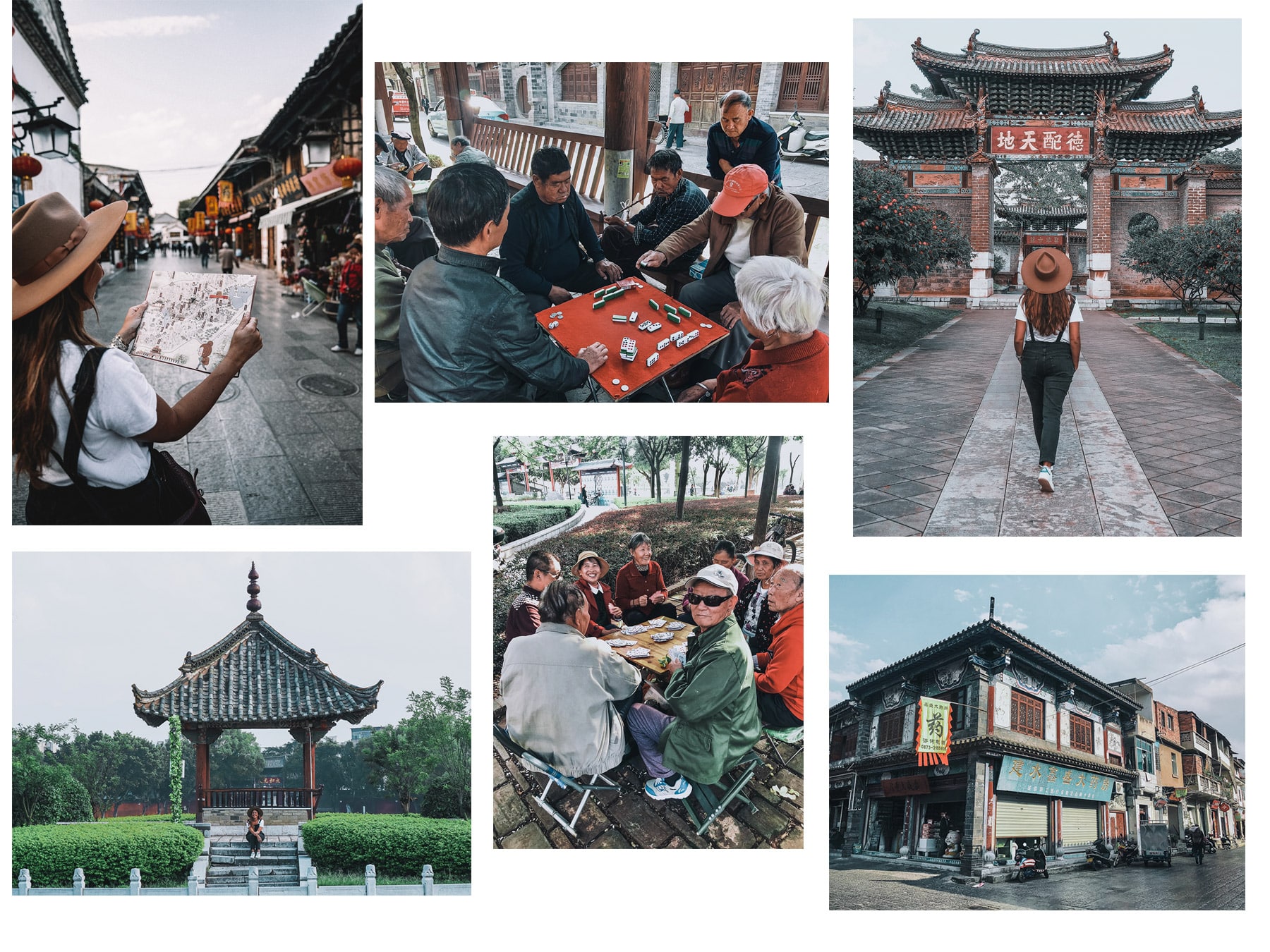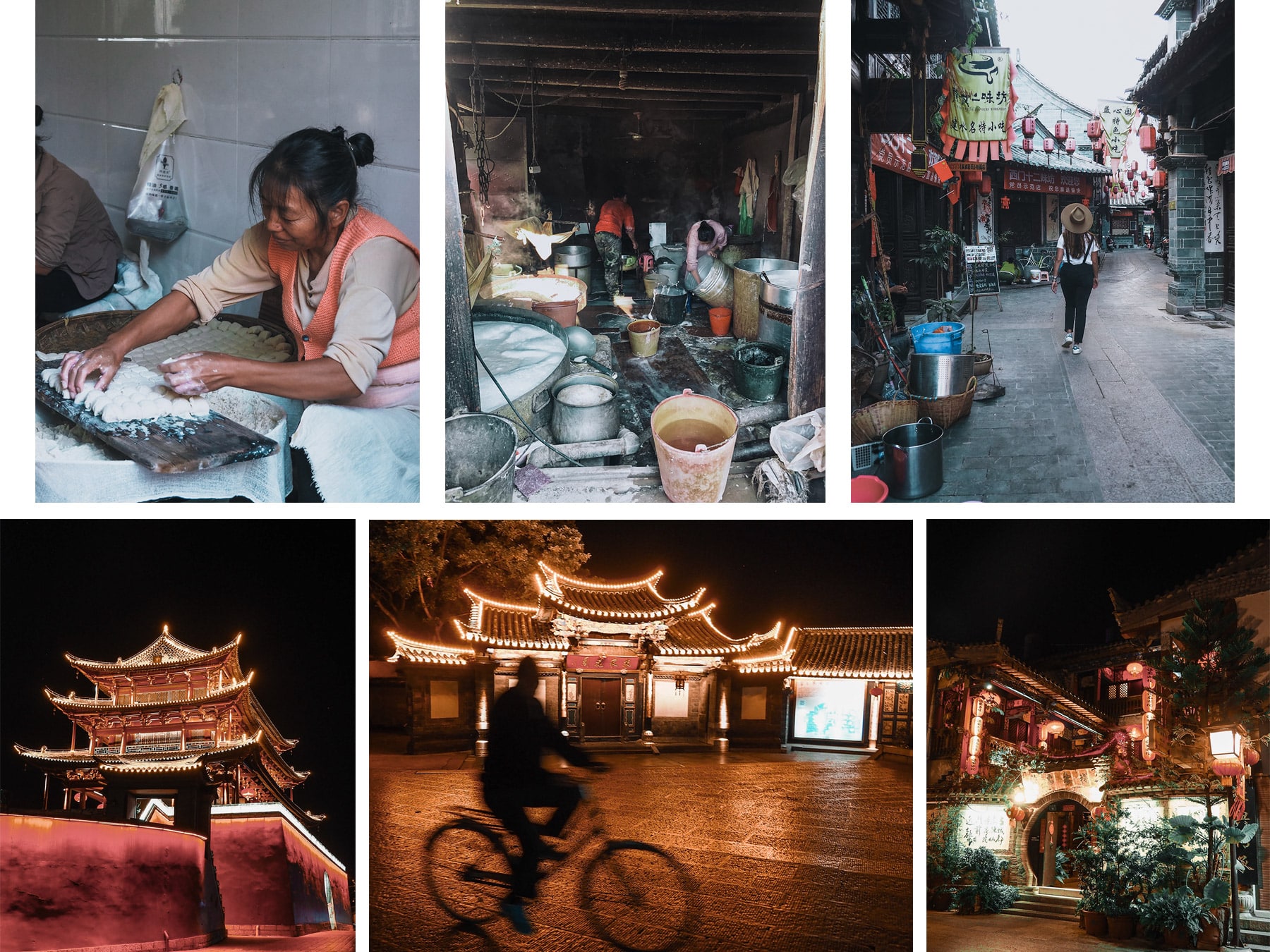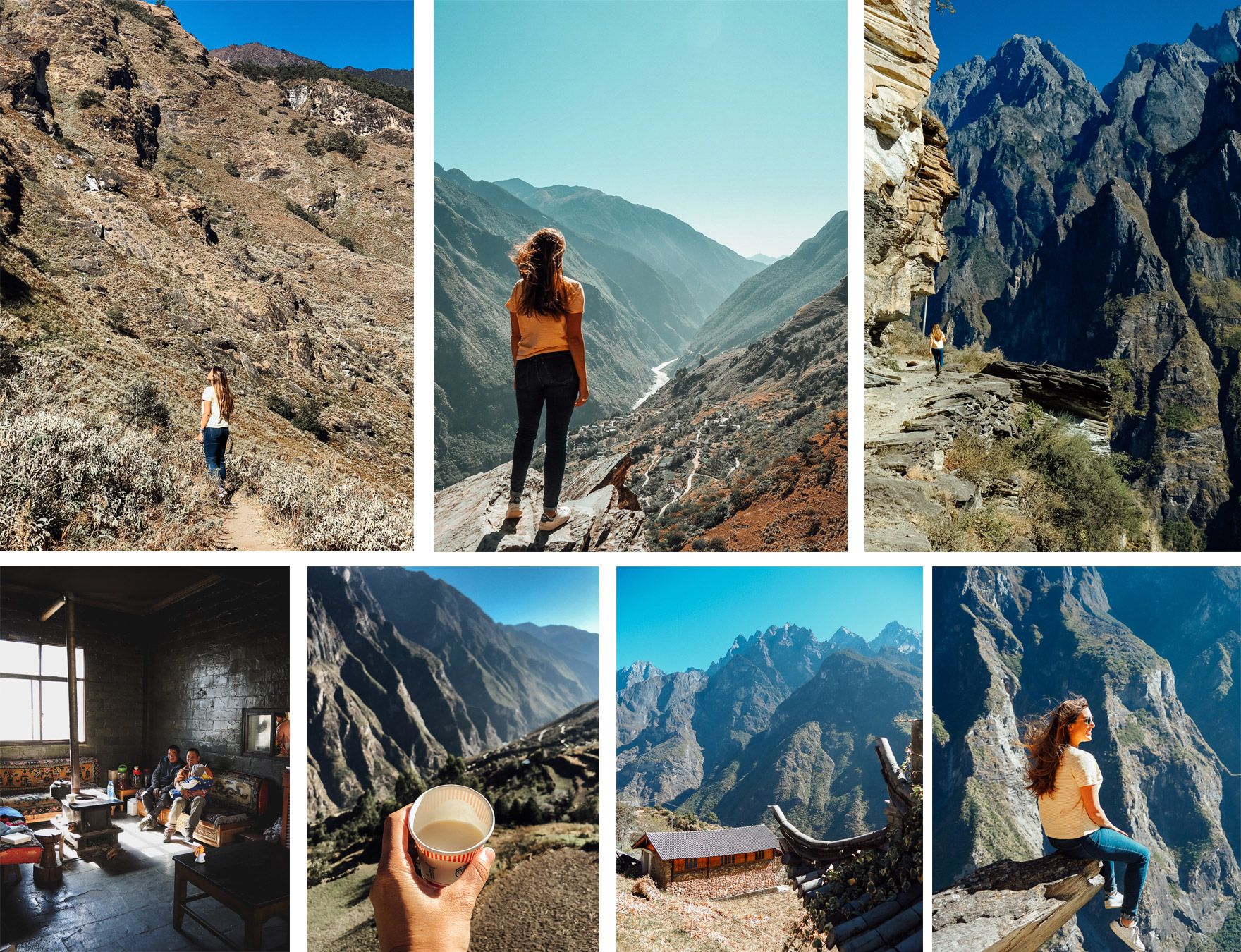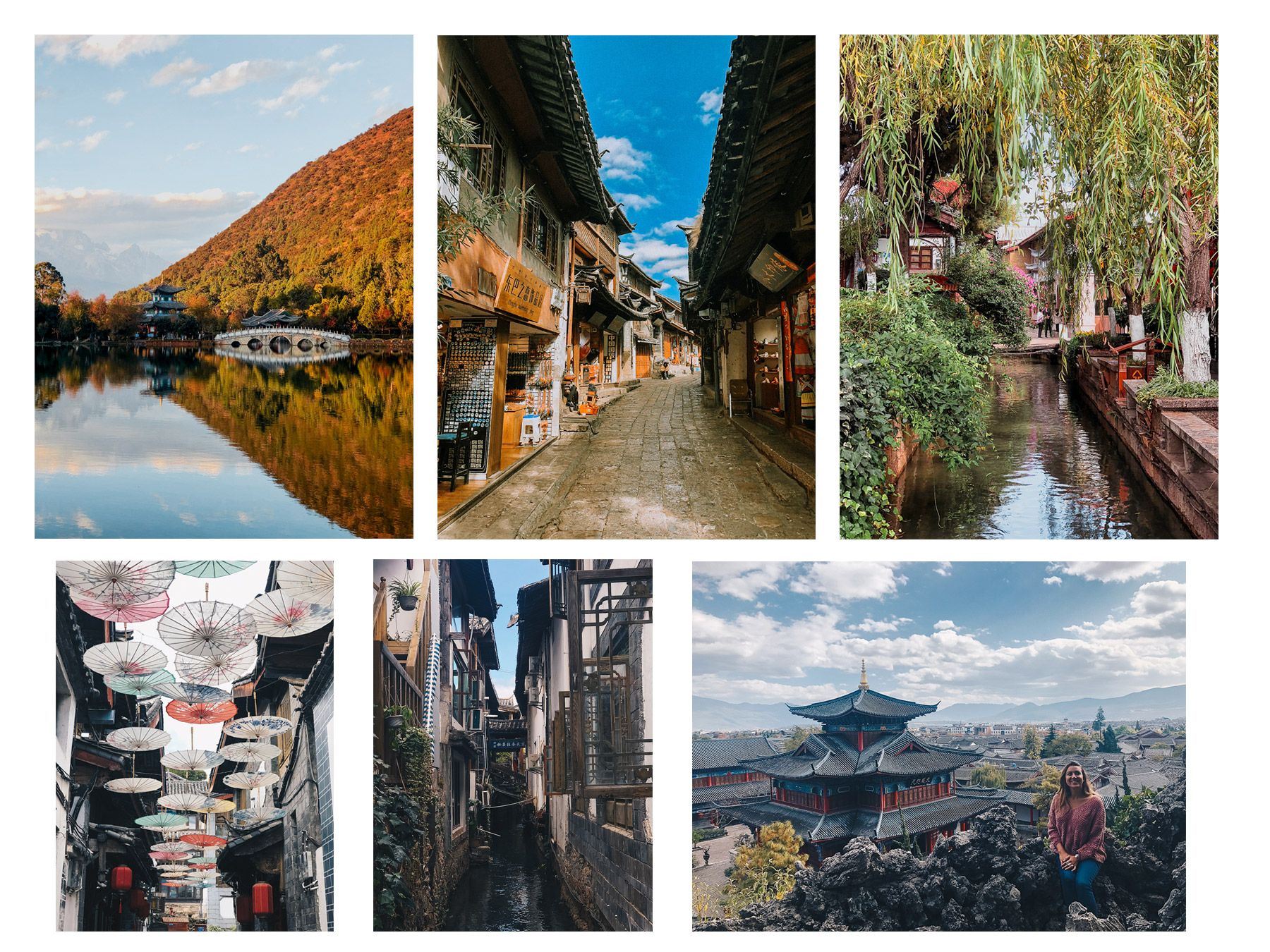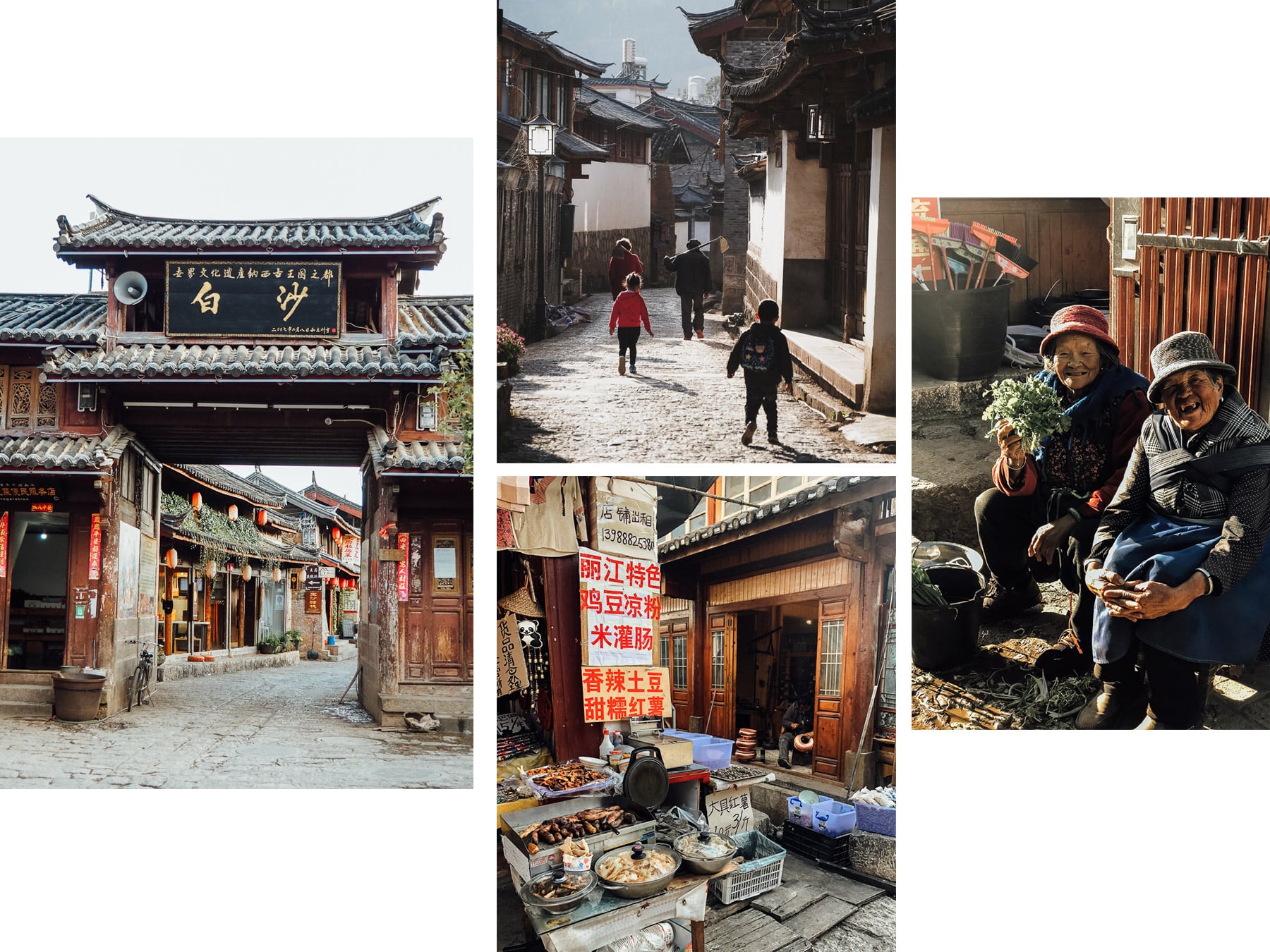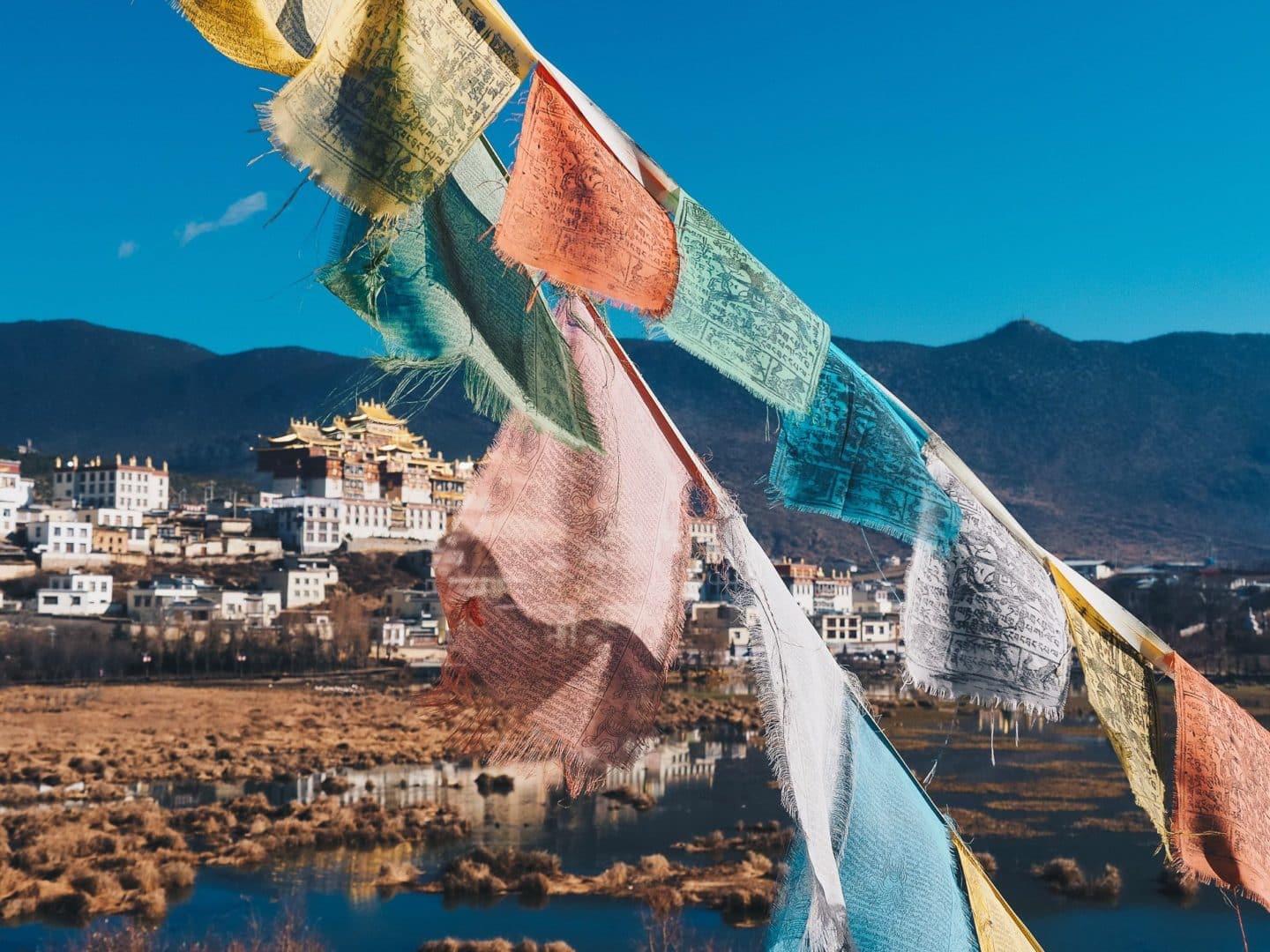
In November, I set off to discover Yunnan, a region in the south-west of the country bordering Burma, Vietnam and Laos. A look back at our two-week trip to this province, considered China’s most beautiful.
This is the second time I’ve set foot on Chinese soil. The reason we didn’t stop in Yunnan on our Round the World Tour in June 2015 was because we’d just spent 25 days in Vietnam and were afraid of returning to similar landscapes. As a result, we started our trip in China directly from Sichuan and then Guanxi, ending our journey in Beijing. This month-long trip was a disappointment because we didn’t find the authenticity we were looking for, namely the China of yesteryear with its pretty traditional black wooden houses and authentic, unspoilt villages. Instead, we discovered a very modern, expensive China, where you have to pay for everything, and where the old has given way to huge buildings and crazy real estate projects.
That’s why, when I learned that I was going to discover the Yunnan, I jumped for joy when I received the program. Yunnan is renowned for its great ethnic diversity, and ethnicity means potential and unforgettable encounters. China has a total of 55 minorities, 25 of which are found in Yunnan province alone. The landscapes are varied and the region is predominantly mountainous. Snow-capped peaks, rice terraces, lakes and deep gorges. The modern city of Kunming, the “City of Eternal Spring”, boasts numerous museums and temples, including the colorful Yuantong Temple.
SOMMAIRE DE L'ARTICLE :
KUNMING, THE FIRST STOP ON YOUR JOURNEY
After a 10-hour flight and a stopover in Chengdu, we arrived in Kunming, capital of the Yunnan province nicknamed the city of eternal spring, a rather poetic name. Situated at an altitude of 1,890 meters, with a perfect climate thanks to the lake that regulates its temperature, it’s neither too hot nor too cold. I was afraid I’d be disappointed by this metropolis of over 3 million inhabitants, but I was totally seduced by its many parks, old houses and narrow streets, which make you feel like you’re in a tiny Chinese town.
We only stayed a day, but the best way to discover the old Kunming is to get up very early to see the Chinese breakfast vendors, the famous Baozi, those brioche meat buns, smoking on the sidewalk. Lose yourself in the countless charming, lively alleyways, where pedestrians and electric scooters rub shoulders. Here we found a flea market (open from 9am to 6pm every weekend) with second-hand dealers set up on the floor and book sellers. Pretty cool! As we wandered around town, we stopped off at a charming little park to contemplate authentic scenes of life where locals exchanged pigeons, cages and other small birds.
Just outside our hotel, we stumbled into this little neighborhood that could be likened to Beijing’s Hutongs. The hutong is a collection of narrow passages and alleyways. This rather small place is very charming because it has an old pharmacy rather famous, old shops, small restaurants where are made in the street, in front of you Jiaozis (stuffed ravioli that look like Gyozas). We recommend taking a stroll through the city to get a feel for it!
The famous flower and bird market located between Jjinxing Street and Guanghua steert is a small local market where you’ll find not only flowers and birds but also fish, reptiles, snakes; pets, clothes and antiques. This is the market of souvenirs and bric-a-brac of all kinds, which has lost its charm and can be disturbing when you realize that all these animals are piled on top of each other and some are painted!
Take time to stroll around Lac of Emerald, one of Kunming’s most beautiful parks and stop off at Kunming’s oldest Buddhist temple, the Yuantong temple.
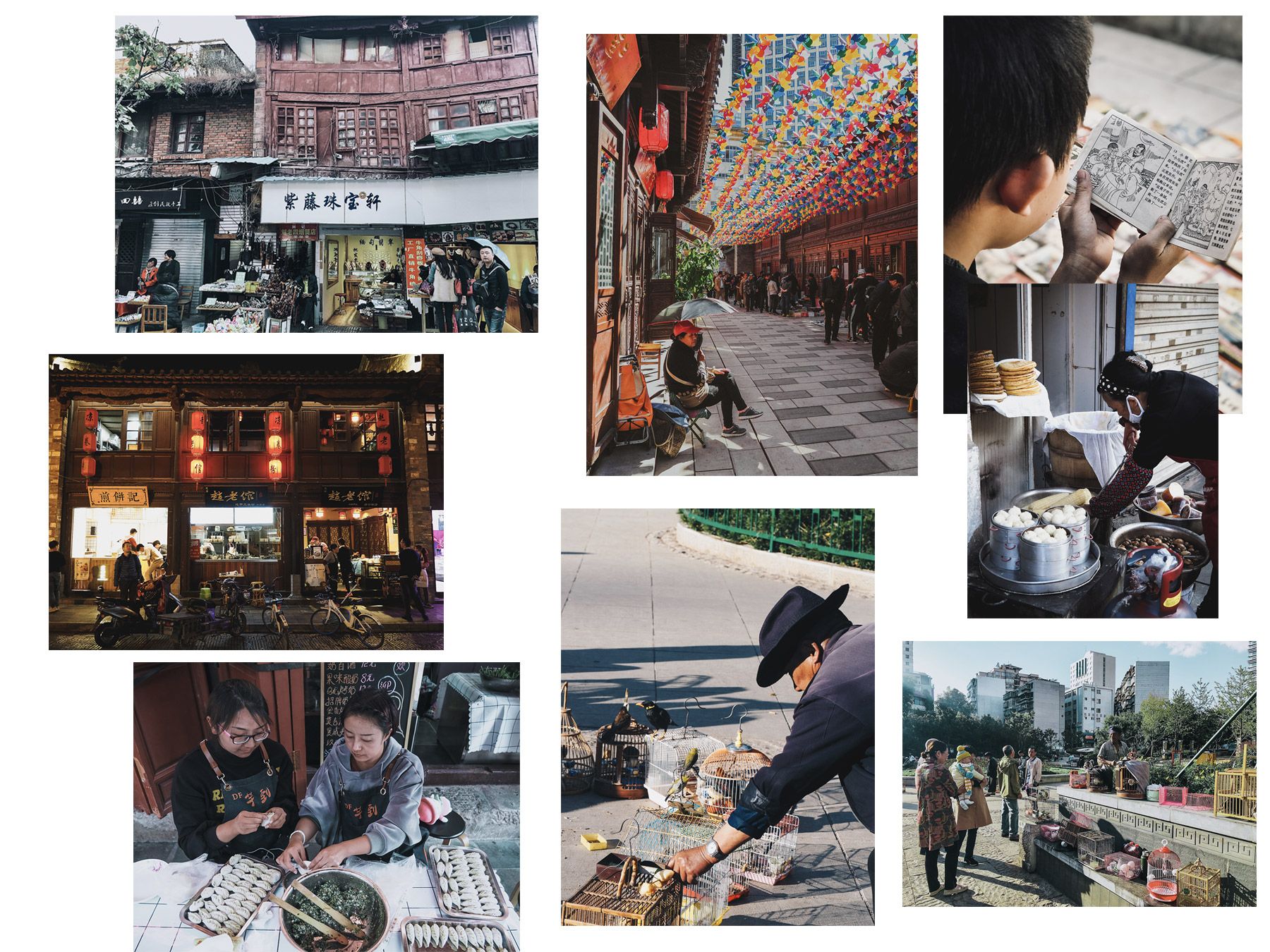
We tested the hotel Moon & Chalice . It’s a brand-new establishment in the heart of Kunming’s old quarter, with the allure of a trendy Parisian hotel, quite astonishing for a major Chinese city. The decor is stylish and contemporary, the rooms are spacious and very comfortable, and the bedding is very good. In short, it’s a great way to start your trip and get your bearings. The hotel overlooks a very pleasant neighborhood and a lively street where old and new meet.
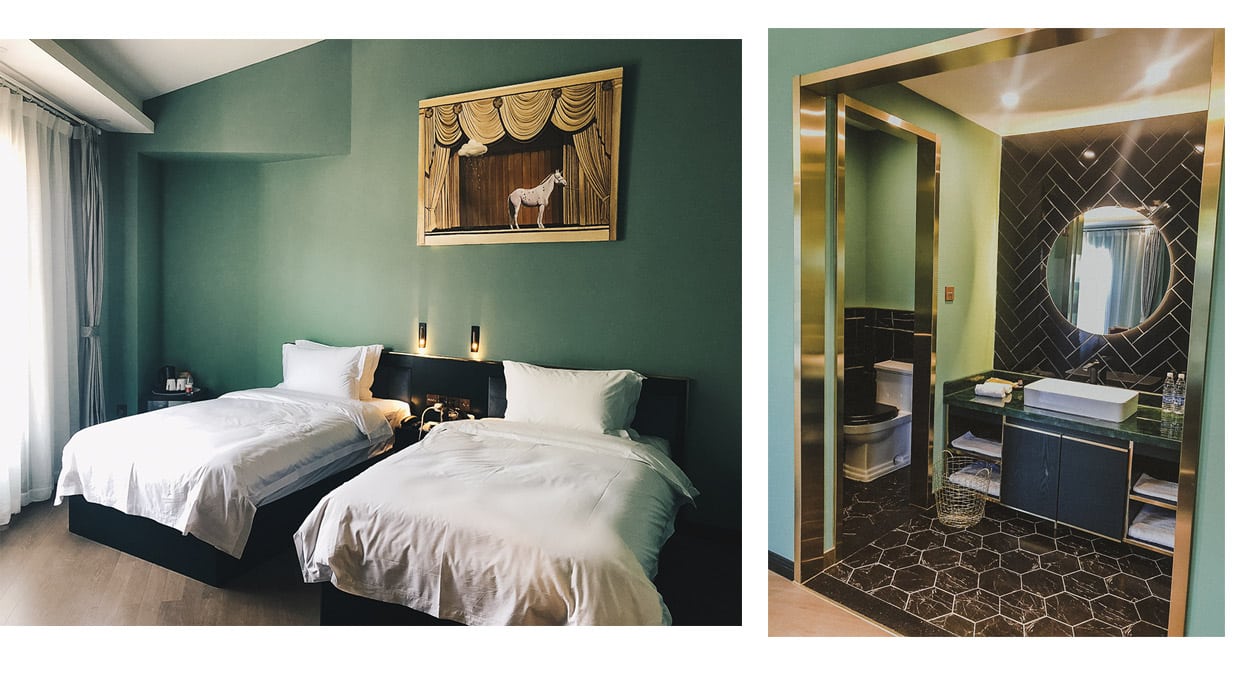
For those who want to treat themselves, I’ve also spotted a small boutique hotel the Silver Chest boutique Hotel between Guanghua Street and Wenming Street or for smaller budgets, you have the Lost garden guest house, all in wood near the Emerald Lake district.
We had lunch in a traditional house at Lao Fang Zi. The setting is lovely and the food divine. Order several small dishes to share between you so you can taste everything. Count 50RMB/p (approx. €6.50) for a very good meal. In the evening, head for the Xiang Yun Jie crossed with Baoshan Street. I thought I was in a Tokyo neighborhood! There are lots of nice restaurants and we chose the Grandma’s kitchen (HuaZhe) (40 RMB/p). It’s not easy to find, as it also goes by the name of Waipo Weidao and is upstairs from a collection of Xiang Yun Mei Shi Cheng restaurants so look up! The food is once again succulent.
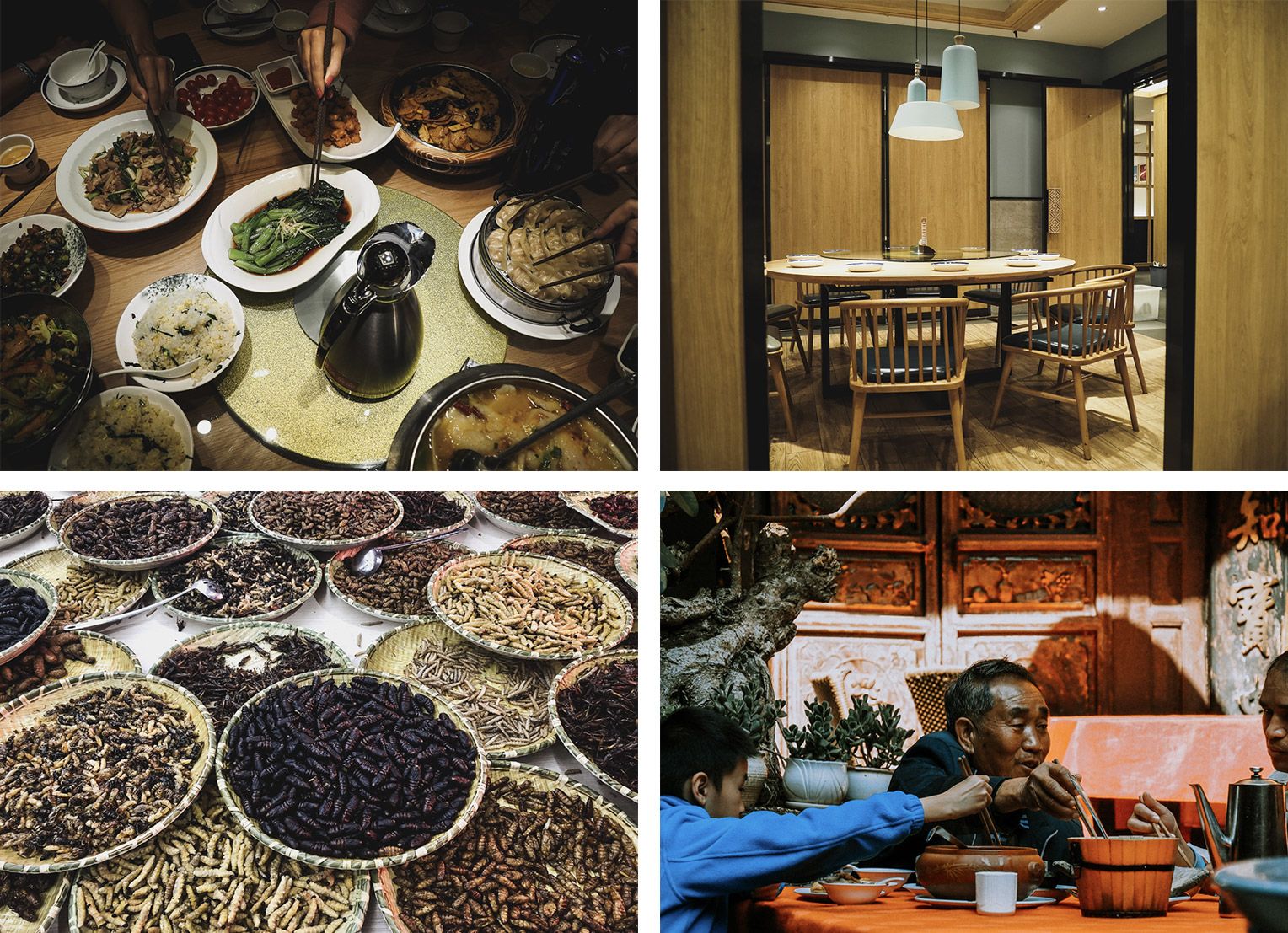
The city is modern, so there are plenty of cafés to choose from. You can test several of them, such as Mr Kun on Qianwang street (beautiful wooden storefront), as well as the café Lazy in the Wuhua District. I spotted it for its very Chinese, contrasting architecture in the middle of this big city. Other cafés are clustered on Guanghua Street, between Wenming Street and Duanshi Street.
On the other side of Emerald Lake, Margot de youmakefashion advised us to try the coffee As You Like. It’s a really unexpected place, and not easy to find! The café is in a tiny alleyway surrounded by brick walls and barbed wire, just behind the main avenue. At first glance, I had the feeling I was heading down a cut-throat street, but this little doll’s house is really nice and cocooning. We enjoyed a delicious chocolate smoothie and pastry. The pizzas are apparently famous and delicious. A place I’d even recommend for working or relaxing, as there are plenty of little sofas upstairs. Count €5/p for a drink and pastry.
Right next door to As You Like, we spotted the Origin Club on Wenlin Street, not far from Hong Dou Yuan, a place that’s a bit trendy but which seemed very nice to us!
THE SHILIN STONE FOREST
A 1h30-2h drive from Kunming is the beautiful stone forest of Shilin. This 8-hectare park features limestone karst peaks formed 270 million years ago. At first glance, I wasn’t thrilled by the place, as the park entrance is very clean and well laid out, once again made for tourists, but in the end, as you wander down the many paths, you can wander through some pretty dizzying natural formations, with some peaks reaching up to 30 metres in height. The landscape could resemble a film set, with all its stone labyrinths. Don’t hesitate to get lost and leave the marked paths, as this is a beautiful walk that requires at least 2 to 3 hours’ walking. We ventured up to the first lookout point, which gives you a great overview of this immense site.
We advise you to avoid weekends and to leave Kunming early to avoid the hordes of tourists who flock here mainly in the afternoon.
Forêt de Pierre entrance – 130 RMB/p + 25 RMB/p (time-saving shuttle)
YUANYANG RICE TERRACES
From Kunming, it’s a 7h to 8h drive to a beautiful Unesco World Heritage site, the famous Yuanyang rice terraces. As it’s a long day’s drive from Kunming, we recommend cutting it short in the morning, with a visit to the stone forest at Shilin.
Yuanyang, this is the region of the Yi and Hani minorities, but also of colorful markets, and for me it’s undoubtedly my favorite part of Yunnan. The rice fields are incredibly beautiful, carved on different levels into the mountains by the Hani minority, who have inhabited the region for several centuries.
JIANSHUI AND TUANSHAN
A 4-hour drive from the rice fields is Jianshui known for its red clay pottery.This pretty town south of Kunming boasts a beauty of traditional architecture that totally seduced me! It’s an ideal place to stroll, store and relax. It is renowned for its Confucius temple, the second largest in China after Qufu, but also for the well-kept Zen gardens of the Zhu family and the big red door Choayang dating from 1389, which marks the entrance to the old town. The lower part of the tower houses a small bird market, while the upper floor is home to a tea room. It’s a lovely discovery that can be visited both day and night. We let ourselves be tempted by an evening stroll to photograph the scenes of life.
On the western side of the city, in a tiny neighborhood, we discover tofu factories, one of Jianshui’s specialties. Through the wood-panelled doors and open windows, you can see the techniques and understand that the water from the well is used to make tofu for the whole town.
A 20-minute drive from Jianshui is the beautiful, unspoilt village of Tuanshan. We loved the traditional gray-roofed buildings, the students who came to get inspiration for their paintings, the pomegranate juice, the little decorating stores. You can easily spend 2 hours wandering through the narrow streets and temples.
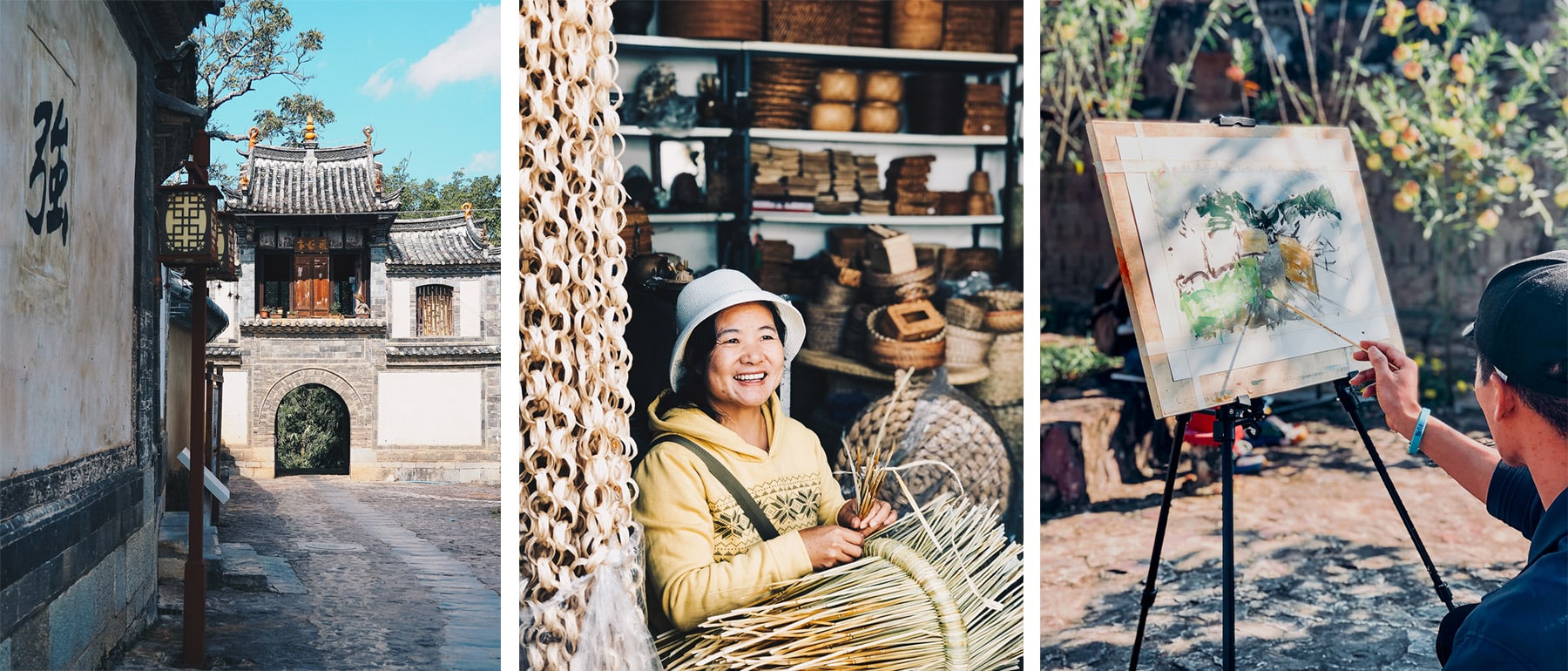
We recommend that you stay in a beautiful, quiet, typical Chinese house in a prime location, the hotel Xiu Ju Xian Ting
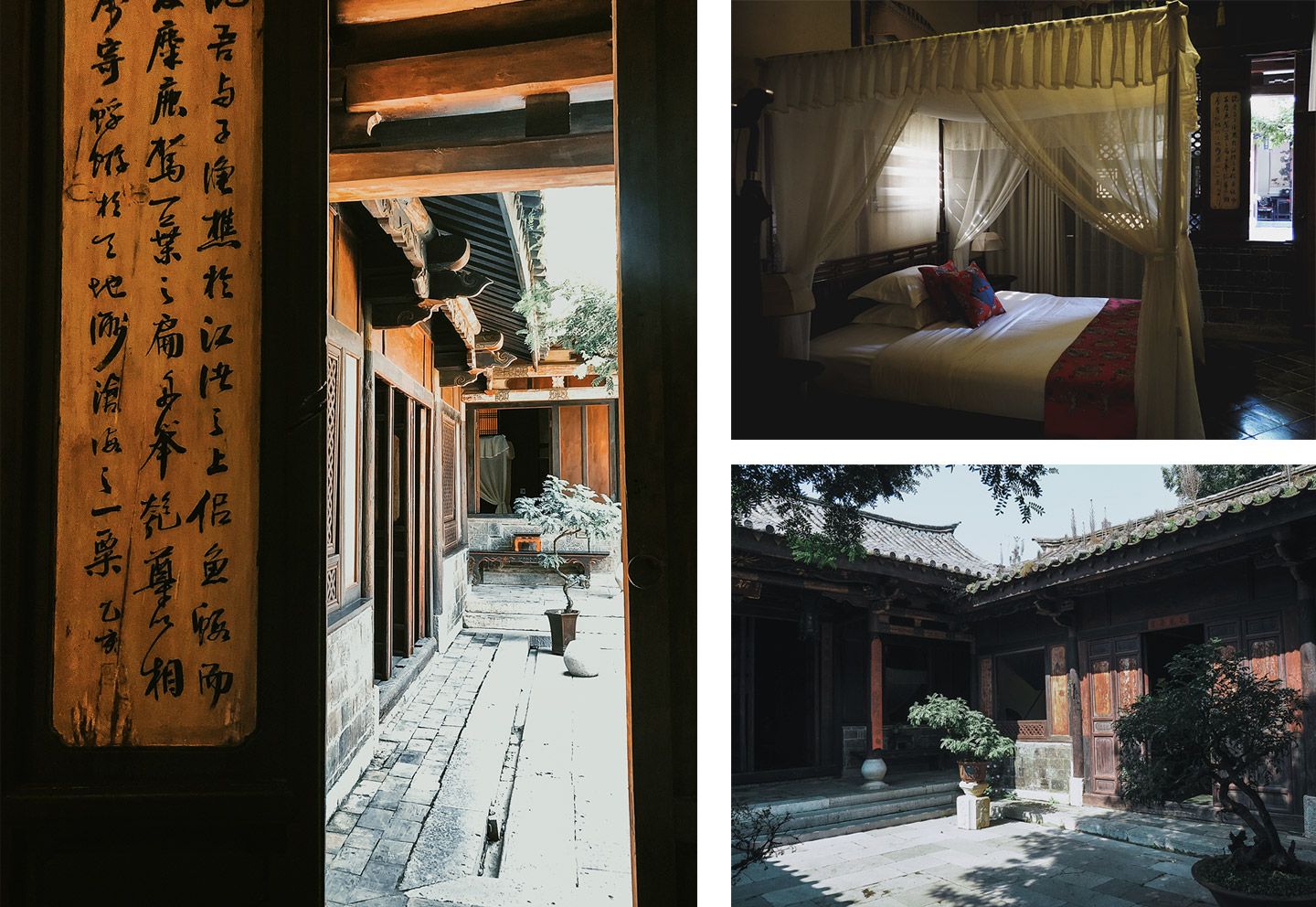
Arriving in Jianshui, we tested Chez Lin, a restaurant where you pay for tickets at the entrance according to the dishes you choose. Once the selection has been made, they are removed directly from the kitchen, so it’s very convivial and very tasty. Try cold pasta, tofu and other delicious soups. The place is beautifully decorated and inexpensive, at around €1 a dish. In the evening, we unearthed a little address found somewhat by chance for a drink, at Xi Men twelve flavours workshop, not far from our hotel. (expect to pay around €4 for a meal)
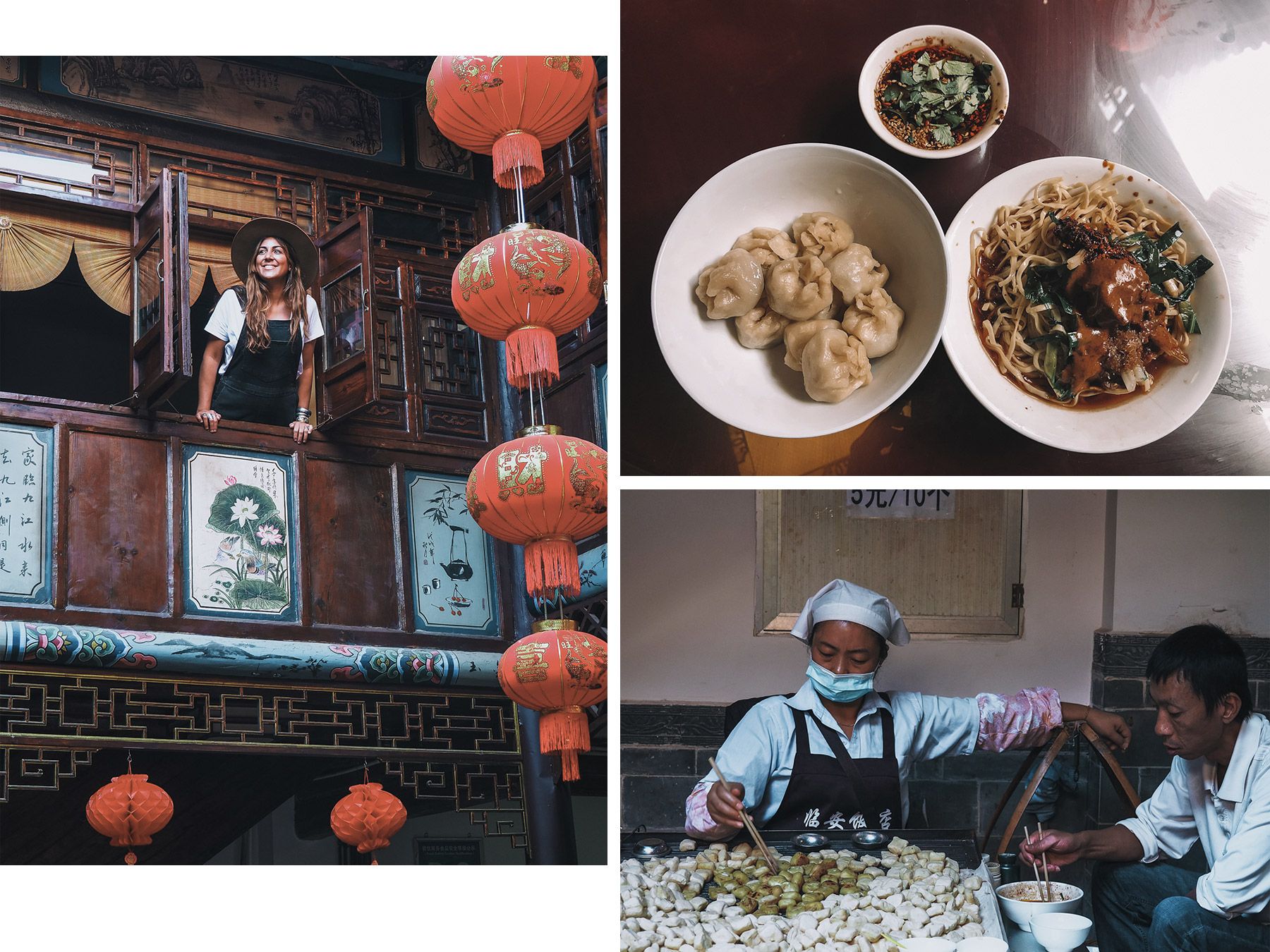
- Entrance to the Confucius Temple in Jianshui– 40RMB
- Entrance ZHU family garden– 35 RMB
- Tuanshan village entrance– 35RMB
XIZHOU AND THE DALI VALLEY
After a 4-hour drive and a 2-hour train ride, we set down our suitcases in the charming village of Xizhou not far from Dali; Xizhou is another favorite stopover, as the village is much less touristy and popular than Dali. If you divide the village in two, on one side of the square you’ll find a silk-thread embroidery workshop in a small hidden alleyway, and a large, bustling authentic market where you can stroll to buy Sichuan pepper, spices, fruit and vegetables and silver jewelry. Then on the other side, past the pretty square and the Chinese arch, we discover a more modern but at the same time traditional part of town, with a long cobbled alleyway housing small coffeshops but also absolutely well-decorated boutiques selling local and natural products, home fragrances and souvenirs. Xizhou is a little haven of peace that deserves a break for a few days. We took the opportunity to borrow our hotel’s bikes and head out around the lake, discovering the surrounding countryside and small villages in the beautiful sunshine.
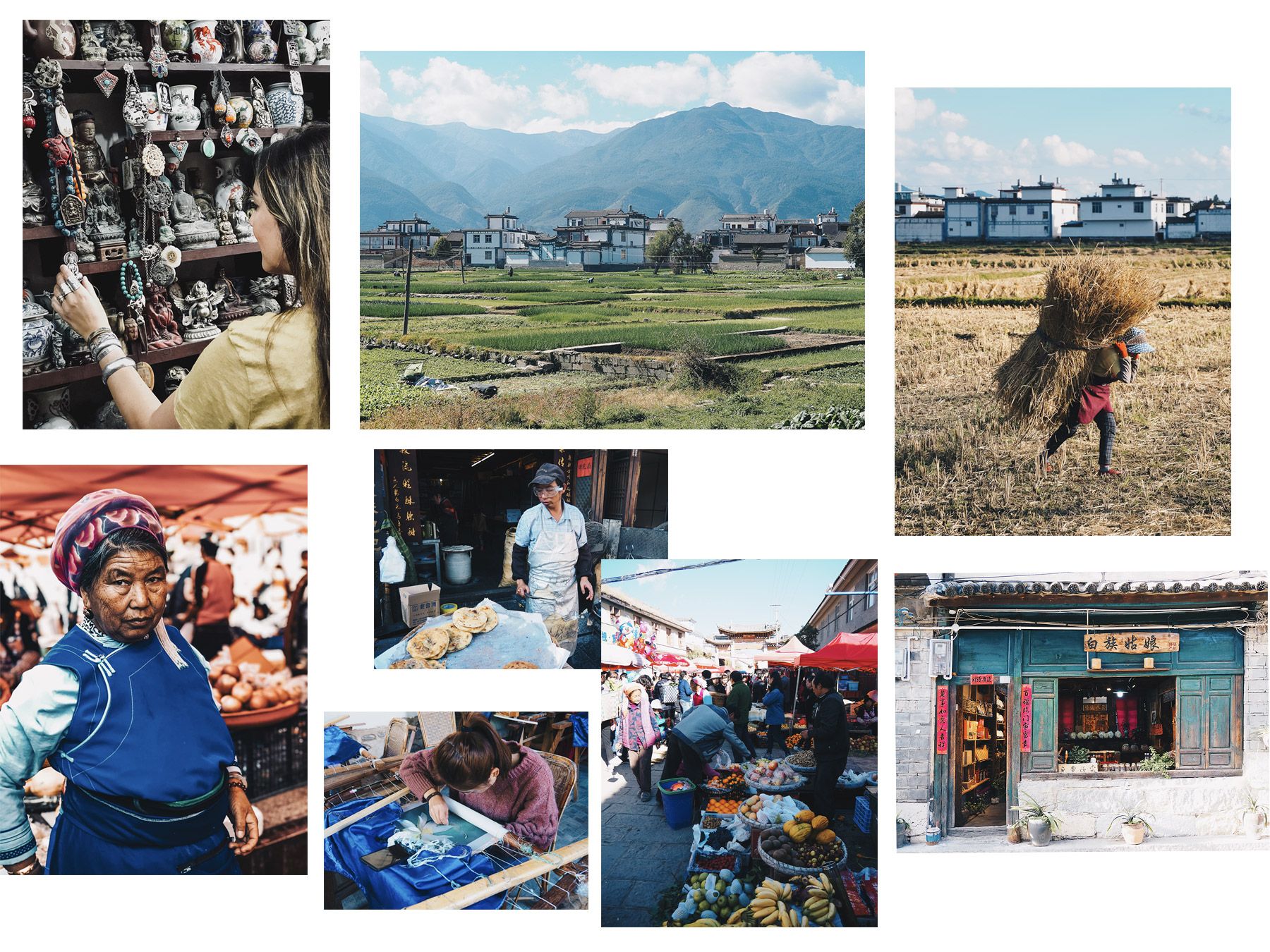 In contrast, Dali, the tourist capital of the Bai minorities, is much more touristy. Old Dali has its charm, but you have to get off the main roads and lose yourself in the perpendicular alleys.Here we discovered the temple-shaped Catholic church, rather original but also the Temple of the 3 Pagodas, the largest Buddhist temple overlooking the city. The site is huge, and can be visited on foot or by taking the shuttle bus on the outward journey and walking back.
In contrast, Dali, the tourist capital of the Bai minorities, is much more touristy. Old Dali has its charm, but you have to get off the main roads and lose yourself in the perpendicular alleys.Here we discovered the temple-shaped Catholic church, rather original but also the Temple of the 3 Pagodas, the largest Buddhist temple overlooking the city. The site is huge, and can be visited on foot or by taking the shuttle bus on the outward journey and walking back.
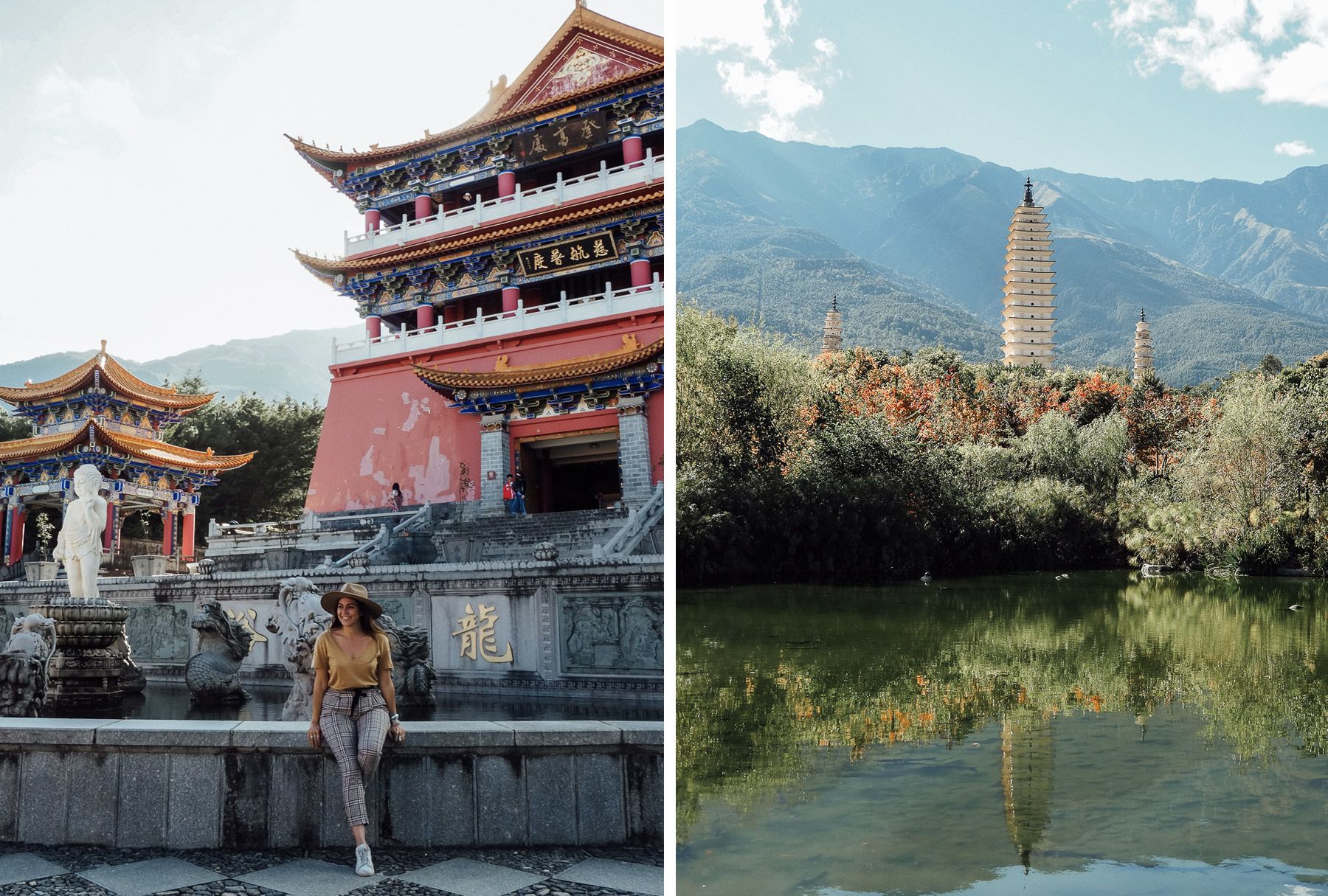
Part of the group chose to discover the Weibaoshan or Weibo Mountain at an altitude of 2,500 meters. The hike was quite strenuous as it took in a lot of stairs, but it was fairly well signposted. It’s a 2? hour drive to get there. Allow 3 hours for the return hike, including a picnic lunch break.
We recommend this old traditional house converted into a hotel, the Linden Center run by Brian, an American who has lived in China since 1984 and works with the government to support the preservation of sites and conserve Chinese culture.
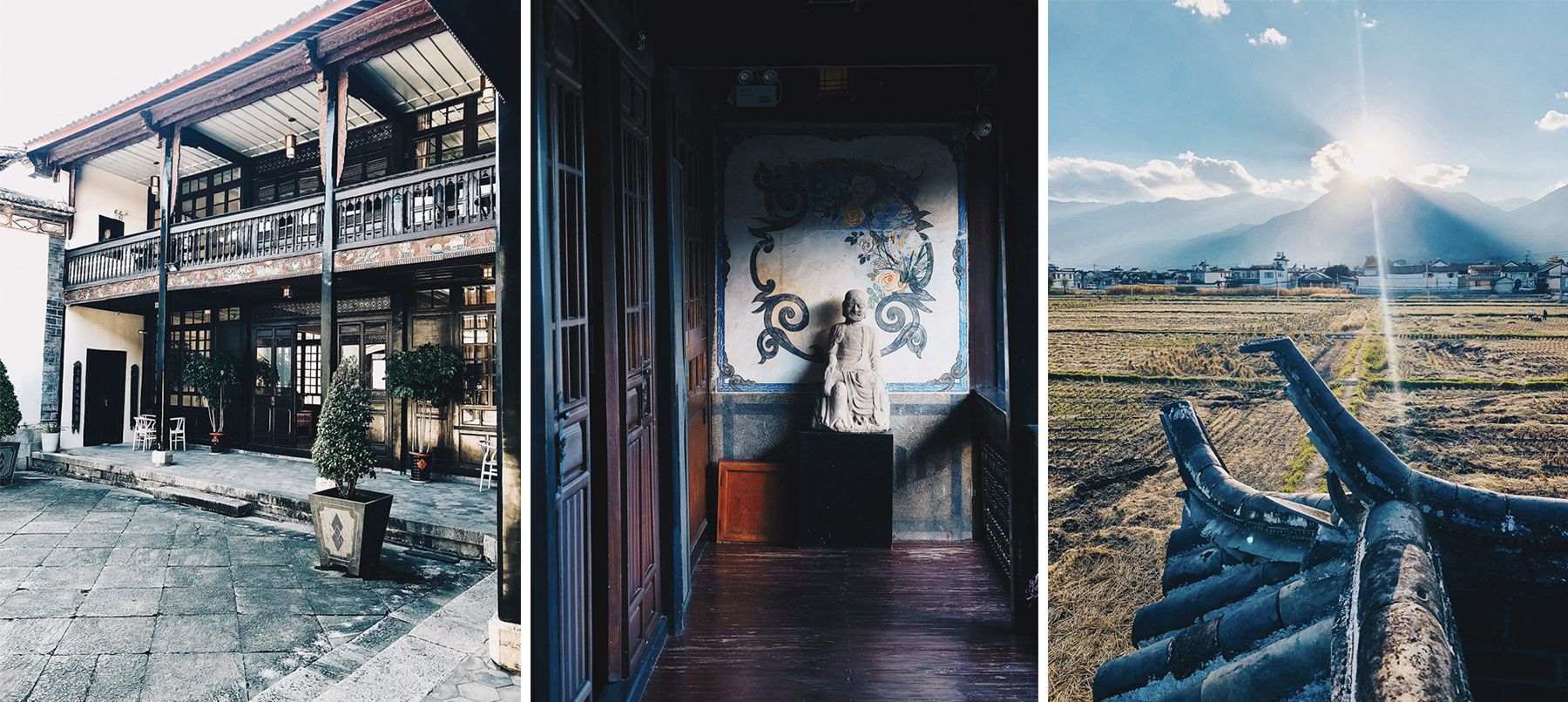
You can try one of the restaurants in the central square – they’re all pretty much the same. Mind you, most of the locals don’t speak English, so we do what we can! Don’t forget to try the local specialty sold in the village’s central square, the Xizhou Baba, a delicious pizza-like local patty. In the evening, book a room at the Hotel Linden, « noodles across the bridge ». It’s a Chinese fondue served with side dishes that you can prepare yourself, and it’s a real treat. Expect to pay around €9/p
In Dali, we tried the all-you-can-eat vegetarian buffet at lunchtime, a stone’s throw from the Wumiao temple. Yiran Tang, only 0.60€/person.There’s no waste here, we eat everything in the bowl! We also tried a few street food specialities like a melted cheese skewer and a waffle covered in chocolate and candy… a bit sickening!
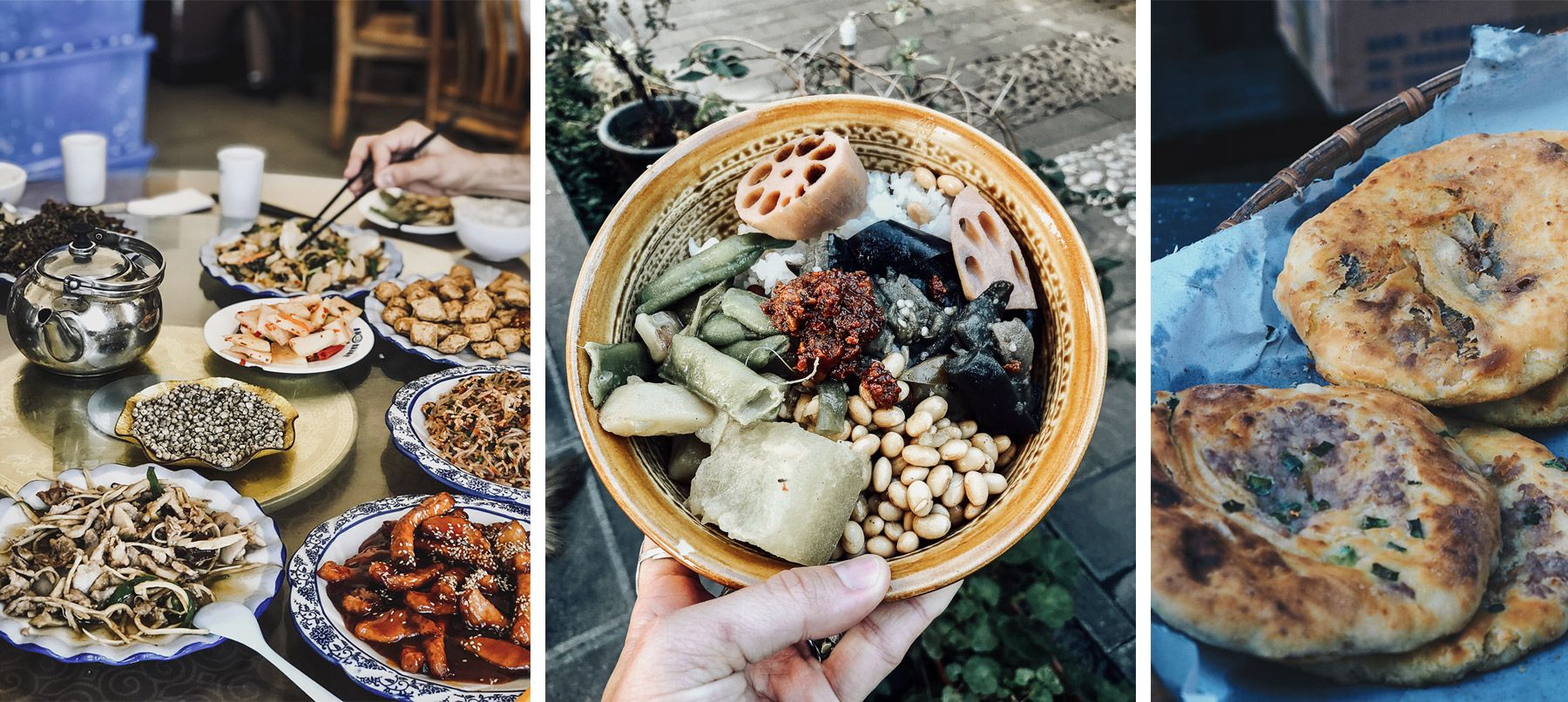
On the terrace of the Linden Center hotel for a 180-degree view of the rural landscape.
Entrance to the Temple of the 3 Pagodas : 9€/p / bus 4€/p or 110 RMB
THE GORGES FROM SAUT FROM TIGRE
China is impressive for its wide-open spaces and hiking trails, some of the most beautiful in the world. Such is the case of the famous Tiger Leap Gorge at an altitude of 2,500 metres in the foothills of the Himalayas. These gorges are 16 km long, 900 meters high, 2000 meters deep, two mountains, Mount Haba (over 5300 meters high) and Mount Shanzidou (over 5500 meters high) and 30 cubic meters of water flowing every second from the Yangtze River. But why Tiger Leaping Gorge? because according to Chinese legend, a tiger jumped 30 metres over the Yangtze River from a huge boulder at the very bottom of the canyon.
The Tigre Gorges can be hiked over 2 days, at a rate of 6 hours a day, or, as we did, over one afternoon, walking part of the way for around 2h30 to the halfway refuge. It’s a beautiful walk, with easy access and no particular difficulties. The scenery is breathtaking and vertiginous!
At the very beginning of the hike is the Jane’s Guest House, a basic inn that distributes trekking maps and the Tea Horse Guesthouse. You can leave your rucksack there and pick it up again at the end of the trek. A bed in a 6-bed dormitory costs around 35 yuan. Alternatively, you can sleep halfway along the route at Halfway Guest House. This is where we had a drink on the terrace, facing the magnificent panorama of the gorge. Count40 yuan for a bed in a dormitory of 6.
You can lunch the Tea Horse Guesthouse at the start of the hike.
If you want to taste something local, stop by Halfway to discover the strange Yak butter tea. Visually and taste-wise, it’s strangely similar to mushroom soup!
Entrance to Gorges du Saut du Tigre site– 45RMB (about 5€/p)
SHANGRILA, AT THE GATES OF TIBET
Shangri-la, a name that has always made me dream and invited me to travel. We’re finally here, in this high-mountain, tourist region just a few kilometers from the Tibetan border. Known as Zhongdian until 2001, the town of Shangri-La lies at an altitude of 3,200 meters and resembles a mountain village with its beautifully crafted shopfronts and smoking wood-burning stoves. At first sight, the old town gave me the feeling of arriving in a ghost town, as I saw very few inhabitants and only a few souvenir stores open. Despite this, you can’t help but love the authenticity and typical architecture. Digging deeper, we learn that the town was virtually rebuilt following a fire, which in 2014 ravaged a large part of the city. Knowing this, Shangri-La remains pretty but loses its charm… in the end, it’s all designed to cater mainly to Chinese tourists, and that’s a shame!
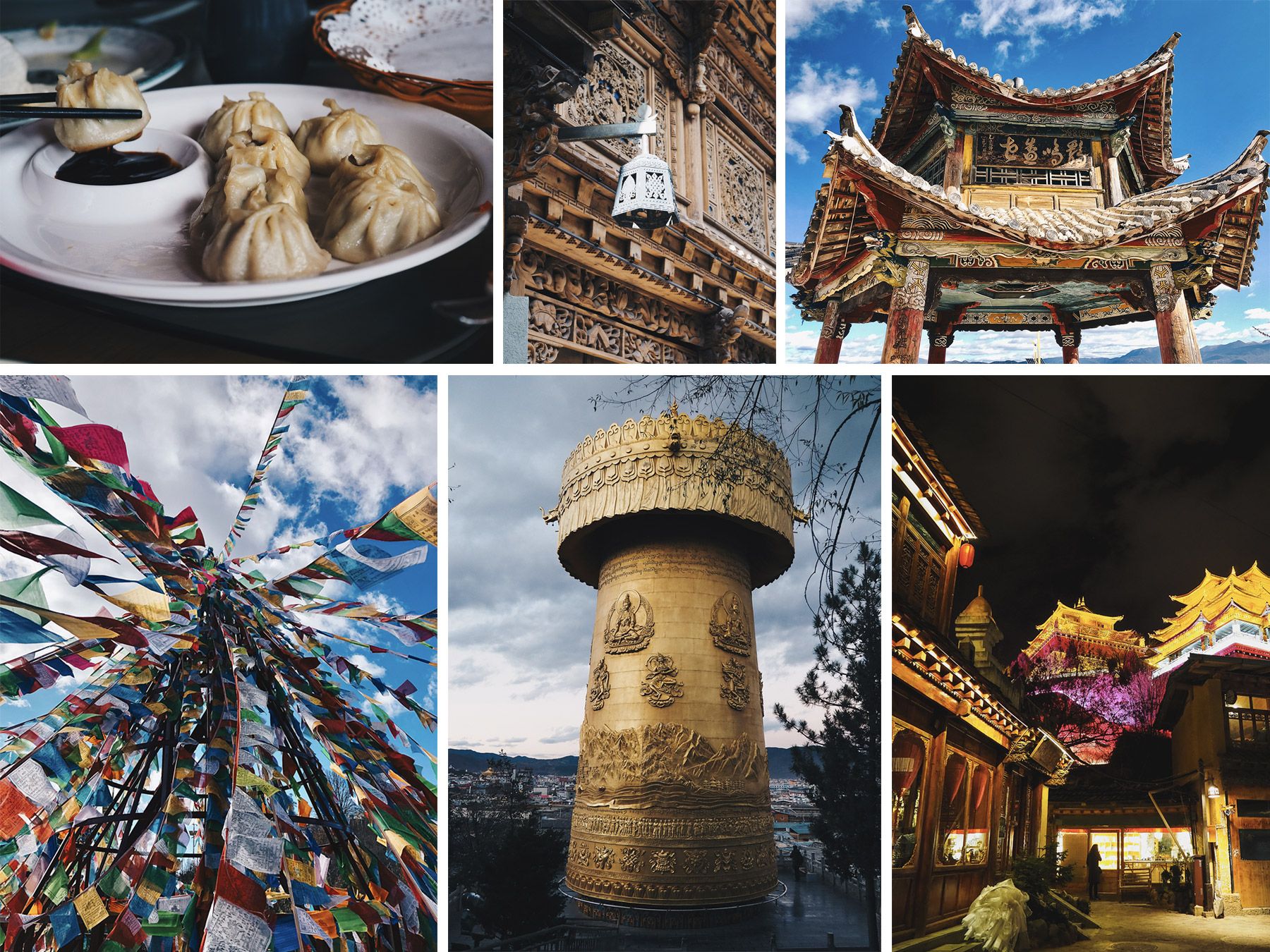
Still, there are some unmissable sites and impressive landscapes like the Songzanlin Tibetan Monastery considered a traditional Buddhist monastery, one of the most important monasteries in Yunnan, home to over 700 monks. Go early to enjoy the morning light and the golden colors of the temple reflected in the water. The walk begins at the lake on wooden footbridges and ends at the entrance to the monastery, where 200 steps lead up to the summit. With altitude, the effort is greater and more physical. The site is magnificent, silent and covered in gold. The paintwork and ornamentation are incredible! Please note that photos are not allowed in the temples, as monks often come to pray.
In the afternoon, you can stroll around the Lake Napa to catch a glimpse of some free-roaming yaks, horses and pigs or climb the hill on foot to the Temple of 100 chickens (Bai ji Si Temple) to admire from above, this panorama overlooking the city. Not far from our hotel, just a 5-minute walk away, you’ll find China’s largest prayer wheel. Did you know that it takes at least a dozen people to make it run?
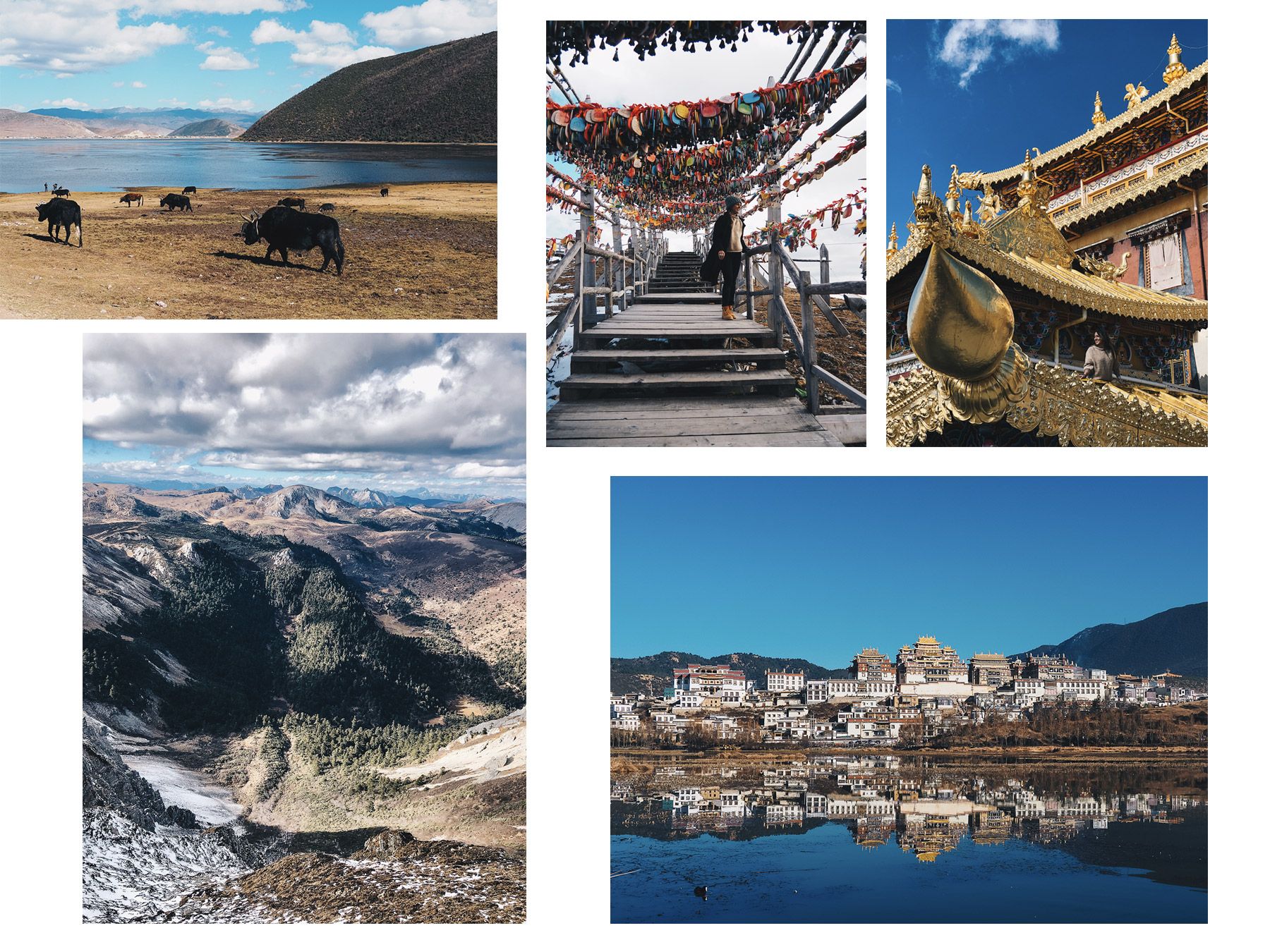 When it comes to encounters, traditional costumes and a change of scenery, a visit to the Shangri-La market situated in the city under a huge hall, it’s an experience in its own right. You’ll find fruit and vegetables, kitchen utensils and, above all, aisles dedicated to yak meat! Sensitive eaters please! I saw a woman cleaning a Yak head in a bucket of red water, butchers cutting up heads, tails, entrails and so on! It’s a bustling place with great scenes of life, a perfect place for photos. Finally, for those who love landscapes and sensations, I invite you to take the cable car up to the mountain Shika at 4500 meters above sea level! The climb takes around 40 minutes, and once you’ve reached the top, you’ll find long wooden walkways already marked out and perfect for taking photos. I didn’t feel the effect of the altitude, but it was very cold at the top, a good -10 degrees!
When it comes to encounters, traditional costumes and a change of scenery, a visit to the Shangri-La market situated in the city under a huge hall, it’s an experience in its own right. You’ll find fruit and vegetables, kitchen utensils and, above all, aisles dedicated to yak meat! Sensitive eaters please! I saw a woman cleaning a Yak head in a bucket of red water, butchers cutting up heads, tails, entrails and so on! It’s a bustling place with great scenes of life, a perfect place for photos. Finally, for those who love landscapes and sensations, I invite you to take the cable car up to the mountain Shika at 4500 meters above sea level! The climb takes around 40 minutes, and once you’ve reached the top, you’ll find long wooden walkways already marked out and perfect for taking photos. I didn’t feel the effect of the altitude, but it was very cold at the top, a good -10 degrees!
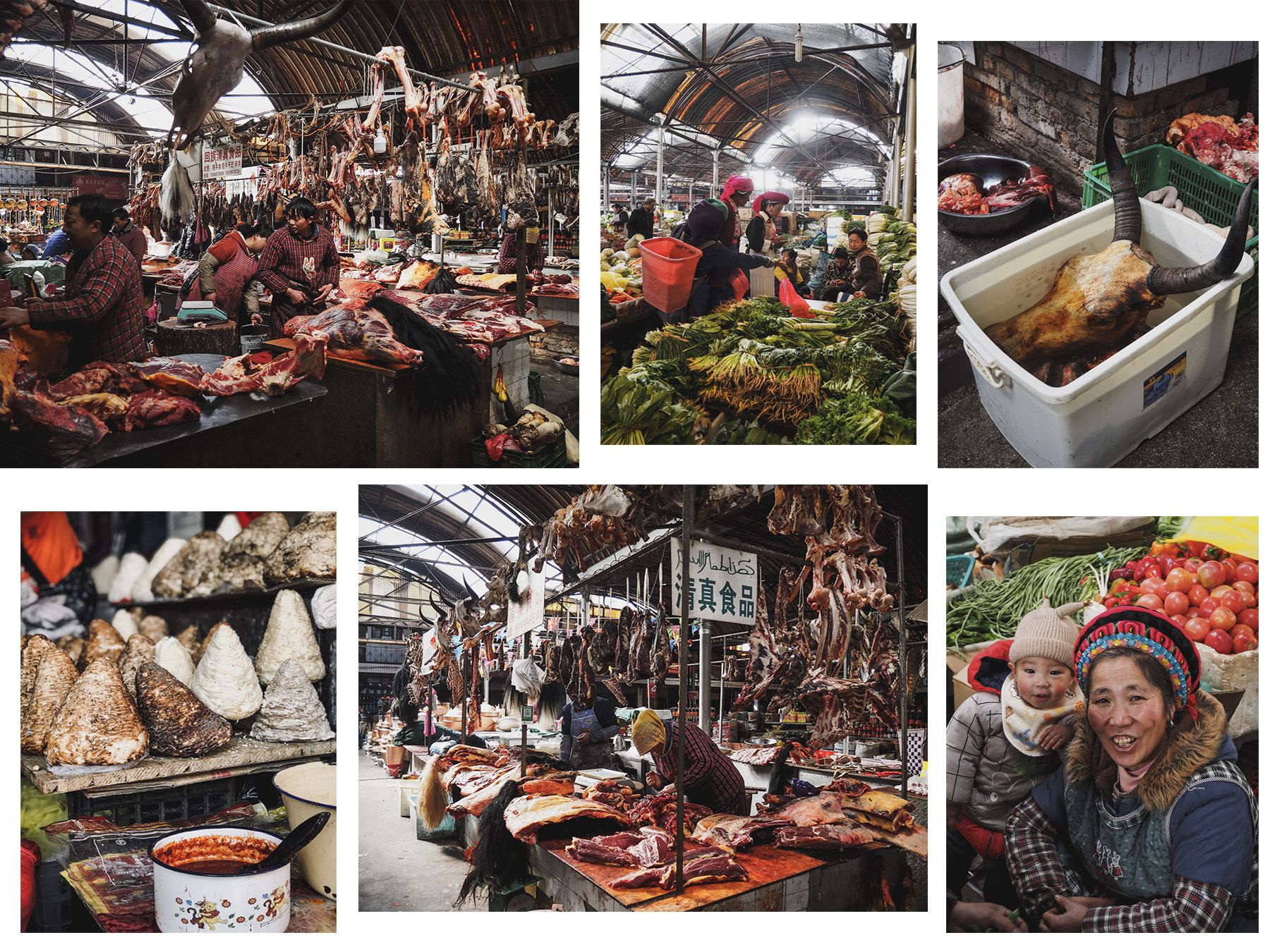 If you’d like to do a bit of shopping, head to the China post in an alleyway where you’ll find plenty of small shops selling stones, fabrics and other souvenirs.
If you’d like to do a bit of shopping, head to the China post in an alleyway where you’ll find plenty of small shops selling stones, fabrics and other souvenirs.
I’m still not quite sure what to make of Shangri-La as I write this, because while I loved the city’s architecture and a few of the locations, I also felt something wasn’t quite as authentic.
The boutique hotel Arro Khampa in the old Shangri-La is a little marvel. The fireplace is just perfect, and their ginger tea is divine. The décor is very carefully designed in a modern Chinese spirit. If you’re looking for comfort and tradition, these are two addresses not to be missed.
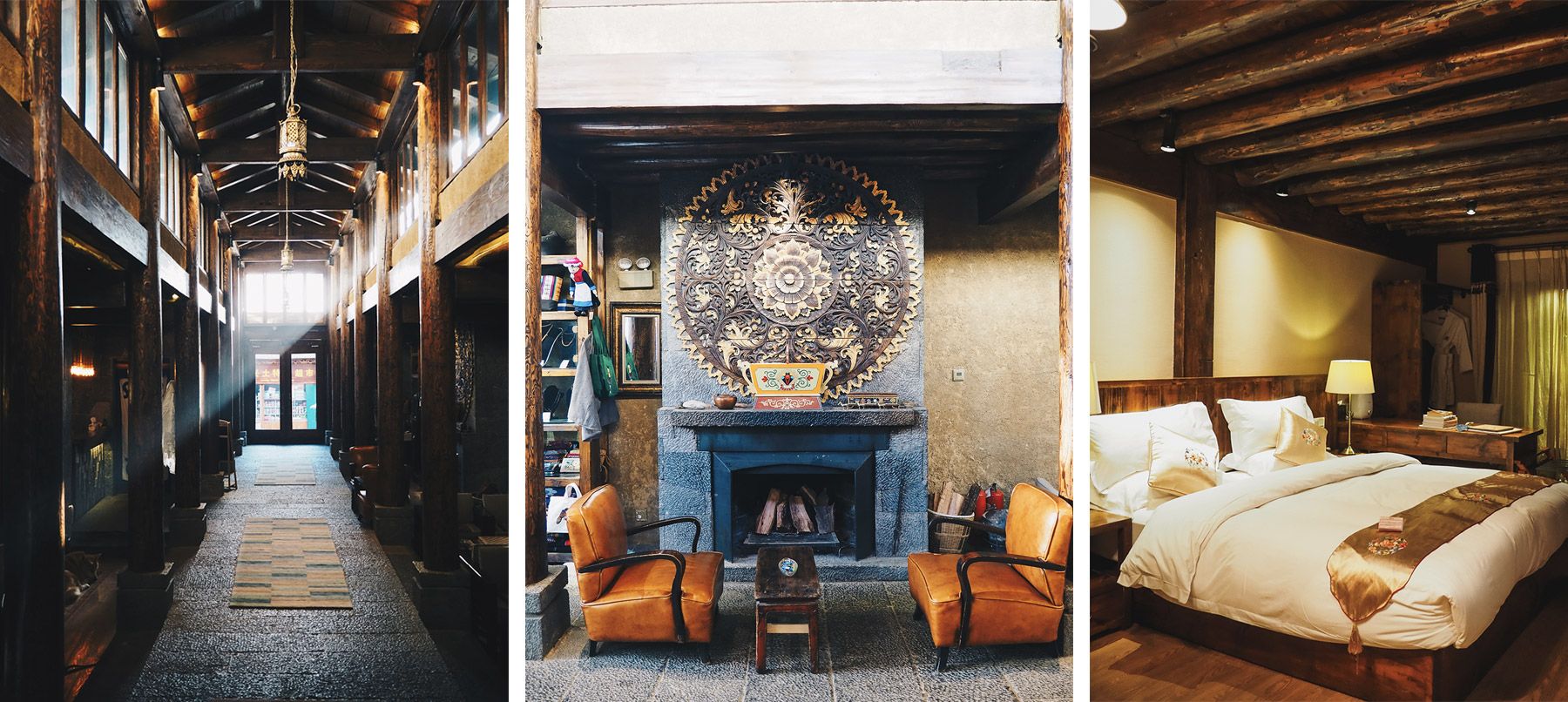
We tried out several addresses: the huksum Kitchen which also doubles as a cat bar to taste the hotpot (BBQ) to share (Yak meat to taste and local beer the Shangri La). For a great Yak burger, head to Flying Tiger, a well-known restaurant run by two friendly Frenchmen. I also recommend the Kailash restaurant, the Ge La Xia can ba on Beimen Road and the Three Brothers (not far from the Shangri-La Royal Boutique Inn) in the old town to discover momos, a local specialty.
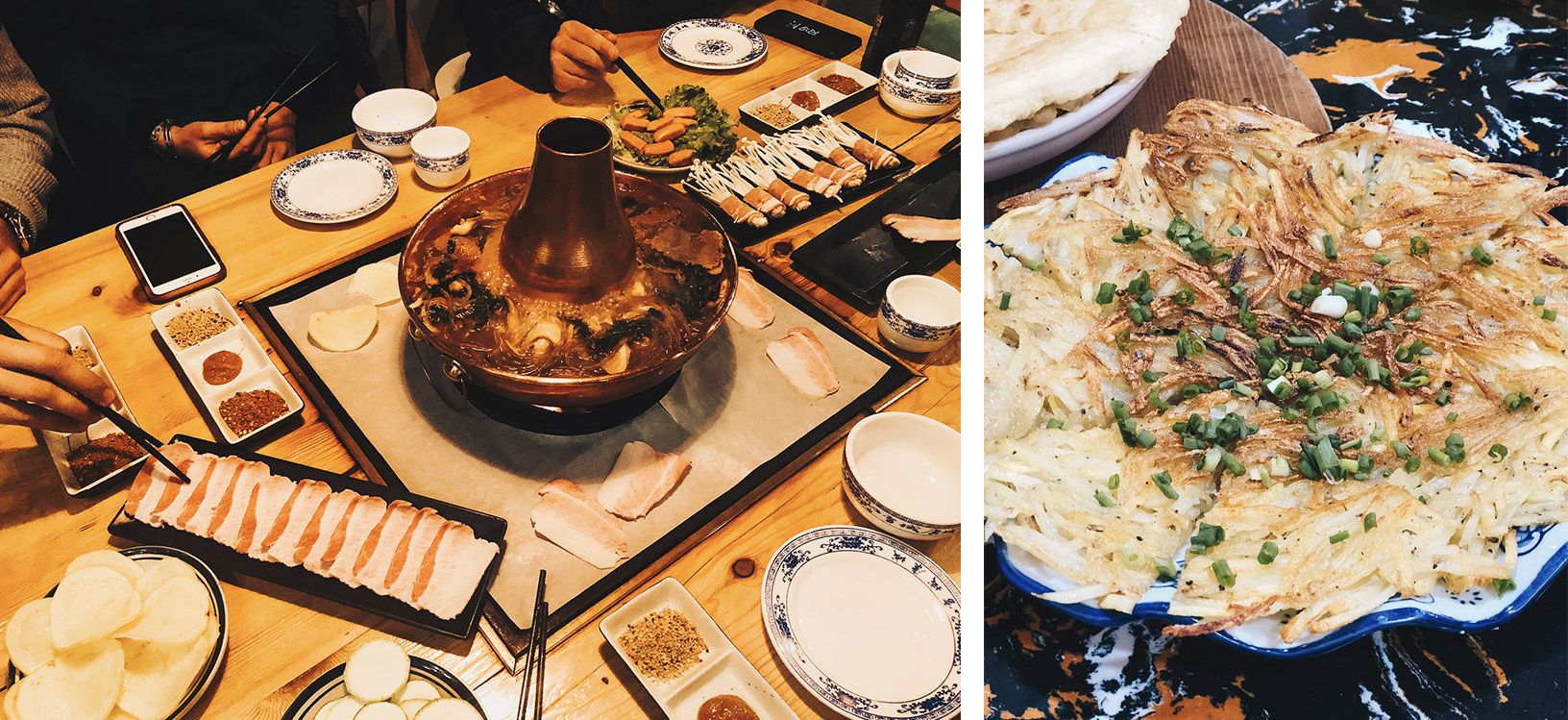
There are several nice cafés perfect for warming up, such as Karma Café & Lodge. All around the Arro Khampa hotel are plenty of cafés.
Entrance to Songzanlin Monastery– 90RMB (approx 15€)
Gondola to the top of Shika Mountain – 200RMB
Chinese prayer wheel: free access
LIJIANG AND BAISHA
A 3h de route de Shangri-La se trouve Lijiang, penultimate leg of our journey. The town is known for its large park, home to a pretty white Chinese bridge offering a fine view of the Snowy Jade Dragon Mountain. Go there at the end of the day for the sunset over the lake, where the autumn colors were magnificent. The city of Lijiang is listed as a Unesco World Heritage. When I first came here, I didn’t necessarily like the city, because I had the impression that it was totally created for tourism. But as I made my way deeper into the old town and down the little perpendicular streets, I began to like it here. The architecture is very typical and grey, with numerous stalls selling a little of everything and often the same thing: souvenirs, fruit, ice creams, teas… I’d also recommend a visit to Mufu Palace in the old part of town, with a pretty good view and relaxing, zen-like gardens.
If you have a little time to spare, head for Baisha, north of Lijiang. This small village has a lot of charm because it’s peaceful and much less crowded than Lijiang. Numerous traditional Chinese houses line the cobbled streets, some of them converted into numerous stalls selling antiques or handmade objects. We entered the courtyard of the Mu family’s silk embroidery school. The work is remarkable!
We recommend the hotel Arro Khampa by Zinc Journey of the same group as Shangri- La, located outside Lijiang city center. This little haven of peace is very modern and the decor is as successful as ever. Particular mention should be made of the beautiful patio with its ponds, and the Zen corner where you can enjoy a cup of tea.
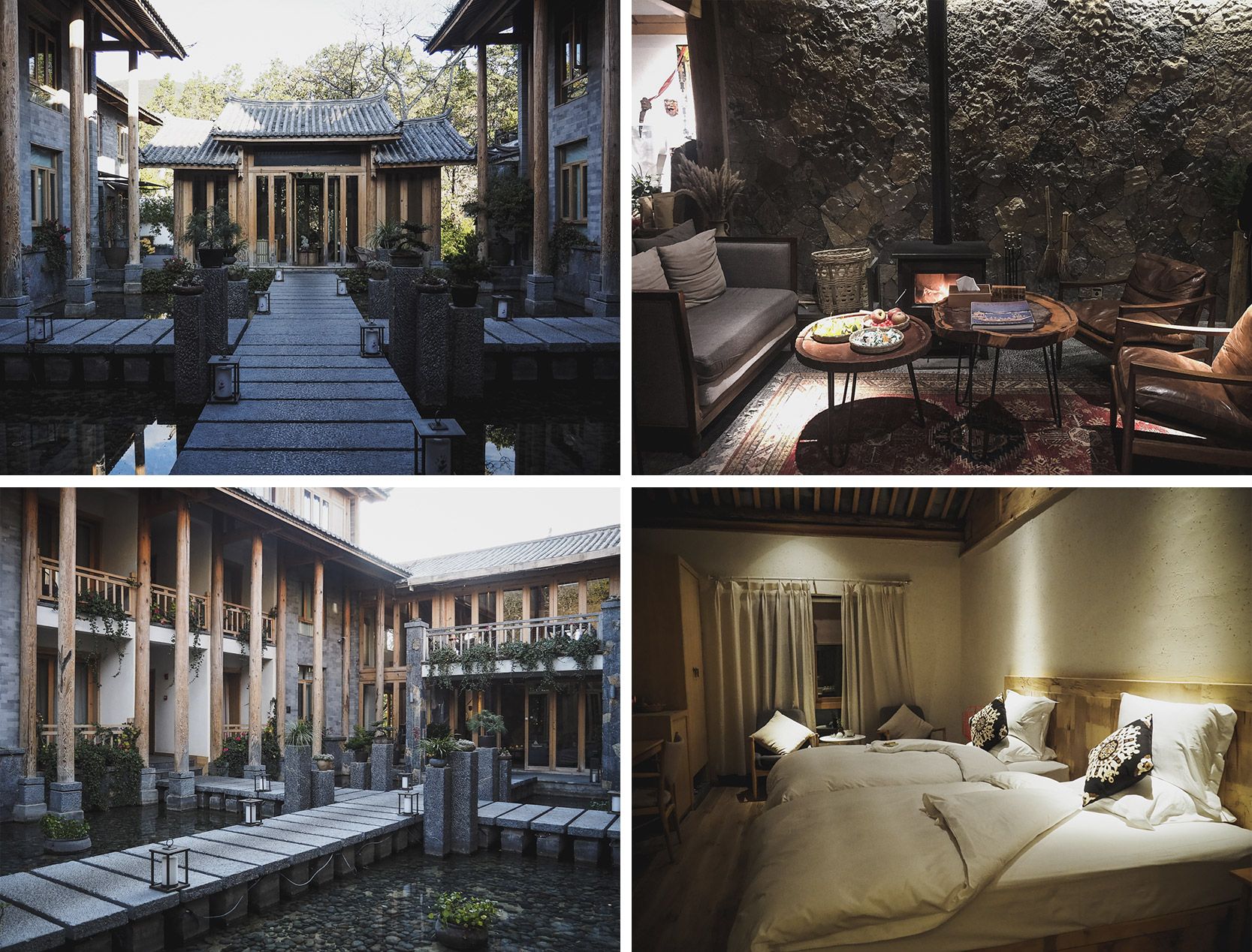
In the perpendicular alleys of the old town, we ordered a multitude of dishes to share, but also at the hotel.
Sitting on a terrace high above the old town on the Yuegulou Bar
Entrance to Étang du Dragon Noir– 80 RMB (approx 10€)
Mu Lijiang Residence entrance– 40 RMB
CHENGDU AND RETURN TO FRANCE
We went to Chengdu to catch our first flight back to France. So we took the opportunity to discover the panda research center. We give you our opinion of this half-day in the company of these animals, emblematic of China. Read our article on pandas.
Yunnan is a real favorite on every level. I never thought I’d go back to China one day, but I have no regrets about accepting this collaboration, which has inspired me to explore other parts of the country. To request a quote for a tailor-made trip to this region, please send an email to contact@mademoiselle-voyage.fr
This article is our experience. This trip was made possible thanks to a collaboration with China Roads whom we thank for their invitation and this discovery.
